Mar 4, 2020
Tales from the Brier Patch
After nearly four decades of the Patch being a staple at every Brier, there has to be plenty of interesting stories to tell. Here are a few, as told by the curlers who experienced them. So, grab a drink, find a seat and read some Tales from the Brier Patch.
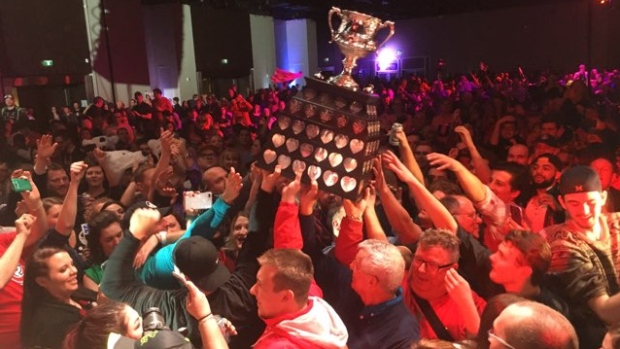
This year’s Canadian men’s curling championship in Kingston, Ont., will feature the 38th edition of the famous Brier Patch.
Officially established in 1982, the Patch has been a place where curlers and fans alike have come together during Brier week to make new friends over a drink (or two), enjoy each other’s company, watch live musical entertainment and to have some good, old-fashioned fun.
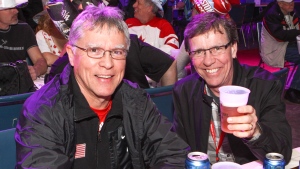
From a small room in Brandon to an indoor soccer field in Regina to a massive tent in Winnipeg, the Brier Patch has come in many shapes and sizes over the years. The musical acts have been wide-ranging as well, from major headliners like Blue Rodeo and Burton Cummings to local performers trying to make a name for themselves.
Whatever the form, the Patch has always been a place where good times are had and lifetime memories are made. After all, in what other sport can you head to the bar after a game and mingle with the athletes? That list is pretty short and it starts with the game played on the pebbled ice.
After nearly four decades of the Patch being a staple at every Brier, there has to be plenty of interesting stories to tell. Here are a few, as told by the curlers who experienced them. So, grab a drink, find a seat and read some Tales from the Brier Patch.

Quebec Sings ‘O Canada’ (Kamloops, 1996)
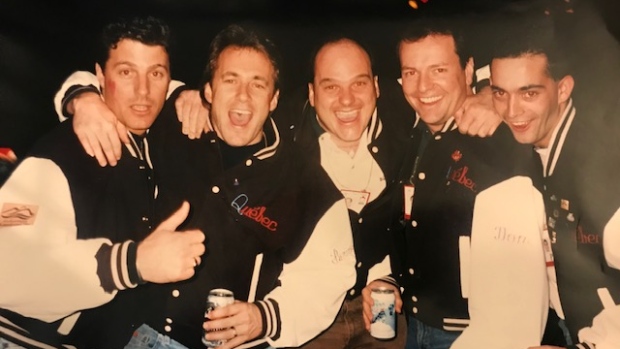
In 1995, Quebec faced the possibility of becoming an independent country, effectively separating from the rest of Canada, leading to a high-stakes referendum vote on Oct. 30, 1995. A record 93.52 per cent of the province’s voting population turned out to have their say. The “No” vote edged the “Yes” side by the slimmest of margins, 50.58 per cent to 49.42 per cent, as Quebec remained part of Canada, effectively putting an end to any further separation talks.
A few months later, the 1996 Brier took place in Kamloops, B.C. Quebec was represented by a rink out of the small town of Buckingham, featuring Don Westphal at skip, Daniel Lemery at third, Louis Biron at second and Pierre Charette, who would later join forces with curling rock star Guy Hemmings, at lead.
Charette and Team Quebec had a solid week on the ice in Kamloops, finishing the round robin with an 8-3 record before losing to Alberta’s Kevin Martin in the semifinal. However, maybe their shining moment came midweek at the Brier Patch when they decided to sing a stirring rendition of “O Canada” just months after a trying moment in the nation’s history.
Here’s the story, as told by Charette.
TSN: What do you remember about the 1995 referendum in Quebec?
Pierre Charette: It [Kamloops Brier] was shortly after the referendum in Quebec. The day of the referendum a whole [lot] of buses came from all over Canada to Quebec with signs like ‘we love you’ and stuff like that to try and get people to vote against separation. All four guys on the team were certainly against separation so we were happy to see the results.
TSN: Why did you decide to sing “O Canada” at the Brier Patch?
Charette: When we got to Kamloops, back then each team has to go on stage and do something like tell a story or whatever. So, I thought it would be a good idea if we mentioned that the rest of Canada came to Quebec to say that they love us and we just wanted to say that we love you too, and we decided to sing the national anthem.
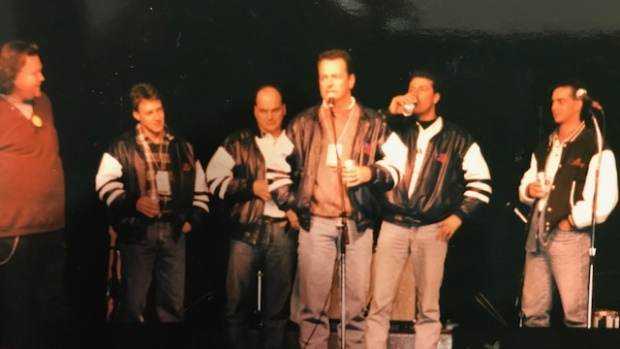
TSN: What was the reaction?
Charette: It was pretty emotional. There were a lot of tears in the crowd. After we finished and after we came off the stage, I mean everybody came up to us to acknowledge what we did. The next day we got a telegram from Daniel Johnson Jr. who was the Liberal leader and the leader of the opposition back [in Quebec] then. He congratulated us on what we decided to do. It was a cool moment.
TSN: Did you plan ahead of time to sing the national anthem, or was it a “spur of the moment” type thing?
Charette: I thought about the idea and they thought it was great. It wasn't planned. It was just something we came up with [at the] last minute. Daniel Lemery on our team would stand up on the plane and sing the national anthem. After a few beers coming back from bonspiels he would pretend he was singing the Russian national anthem and people thought he was actually singing in Russian. It was kind of a funny thing. So, when we mentioned we should sing the national anthem...he just loves to sing. It was pretty heartfelt. Everybody was singing their heart out and the crowd joined in and all stood up.
TSN: Was the Patch an important part of Brier week during your playing days?
Charette: Yeah. Especially our team. Sometimes we would say, ‘let's take it easy this week’ and that would last only one day. We would say 'let's go for one,' and we would end up closing the place. We always had a good time and it probably cost us a few wins here and there, but we had a good time – especially those four guys [from the ’96 team]. We curled together for four years and went to three Briers, but we just couldn't get the disciplined side of it ever correct. The chemistry was weird. Lots of talent, but not enough seriousness to get to the end. We made it to the end at the Patch, but not the Brier.
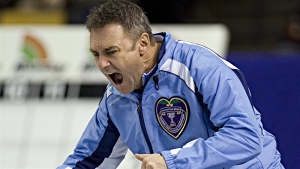
TSN: Any other tales from the Patch?
Charette: My very first Brier was the ’89 Brier in Saskatoon. That was the first of the big Briers. It was completely sold out and that Patch was the biggest bar I ever seen in my life. It was unbelievable. So we actually got lost in there. We walked in and there and said 'let's just meet up at the bar in one hour and then we can leave.' Then we walked in there and it was like eight bars. It was the best Brier ever. I’ve been lucky enough to play in seven of them but that was by far the best Brier.
The Tankard Goes Crowd Surfing (St. John’s, 2017)
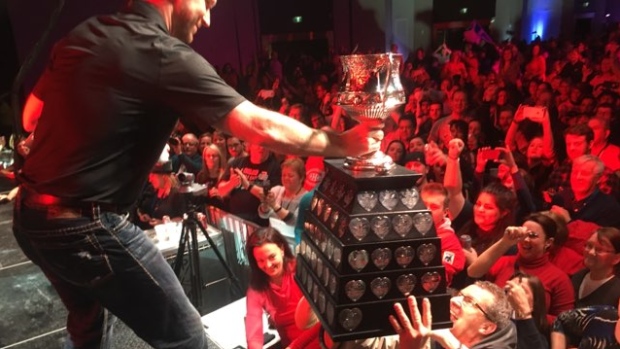
The 2017 Tim Hortons Brier in St. John’s, Nfld., will easily go down as one of the most exciting and memorable.
After so many years of heartache and coming just a little bit too short, St. John’s native Brad Gushue finally won his first Canadian championship after edging Kevin Koe with a last shot draw in the final. Furthermore, it marked just the second Brier title for the Eastern province after Jack MacDuff’s tremendous run all the way back in 1976. To make everything even more memorable, it all happened on home soil.
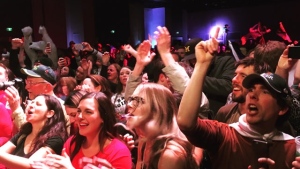
The party afterwards was just as legendary as the week of dramatic curling that proceeded it. And what does every good party have? Well, crowd surfing of course. This version of crowd surfing, however, did not involve any rock stars jumping into hoards of fans. Nope, the Brier Tankard was the star of this show.
Gushue recounts that memorable – and late – night at the Patch after winning the Brier.
TSN: Set the scene for us at the Patch following your win.
Brad Gushue: After a couple hours after the game, when we finished our media and meeting with family and signed all of the stuff, we needed to do to go to worlds, we were told that the Patch is still full and there was still hundreds of people waiting outside to get in. This was 1:30 in the morning. We made our way over and we were just shocked at the amount of people that the were there and the intensity of the crowd. It was one of the cooler moments of my life, to be quite honest, when we walked into the Brier Patch.
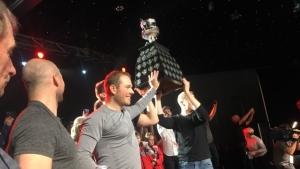
TSN: So, the Patch stay opened? Don’t they usually close it on the final day of the Brier?
Gushue: I think [it] was just kind of an exception. Our team was in the final and the Patch was crazy busy that week. I heard the intentions were to close it at the end of the game, but when we won they decided to keep it open. It stayed open till about three in the morning.
TSN: What’s the story behind the Brier Tankard going crowd surfing?
Gushue: We got up on stage and said a few words. I had the Brier Tankard in my hands and for some reason I thought it would be good idea to pass it around the crowd. The crowd had such a big impact on our win throughout the week...the excitement. We kind of took that energy. We felt like they were our sixth man. My thought was that I would share this with them. And when I passed it out, I saw some of the faces on Curling Canada, the folks that were there, they were a little stressed. I was like, ‘Oh, I don’t know if that was the best idea.’ After a couple minutes of going around, it got back to me and no damage done. I talked to a lot of curling fans that were there and they thought it was pretty cool.
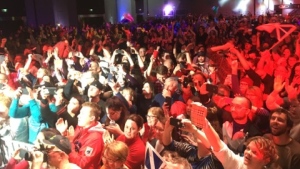
TSN: How synonymous is the Patch with the Brier and its history?
Gushue: I think it’s, to be honest, just as big of an event as the actual curling part of it. I've been to a number of Briers. Some of the Patches are just absolutely massive. They have incredible parties. I remember, I think it was a Patch in Regina, there was actually more people in the Patch than the stands. It's pretty full just about every night. It's just as big as the Brier. I think people who go to the Brier year-after-year, I think part of the reason they do is for the Patch and the relationships they build in the Patch and the fun times, the stories that they take back from it.
TSN: Any other tales from the Brier Patch?
Gushue: I remember in 2004, we were in Saskatoon and we had just lost out in the semifinal or 3-4 game. We had lost a heartbreaker and we went over to the Patch. I hadn't seen the Patch the whole week. I don't tend to go over there much, or if at all, when we're competing, but certainly when we're done. We went over there and I was just kind of amazed at the size and what they did is they had golf carts that would drive around with beer in the back. They let me drive the golf cart for a while and gave me some free beer. I thought that was pretty cool. It took us a couple hours to drive around the Patch with the people coming up. That’s probably the best G-rated story I have from the Patch.
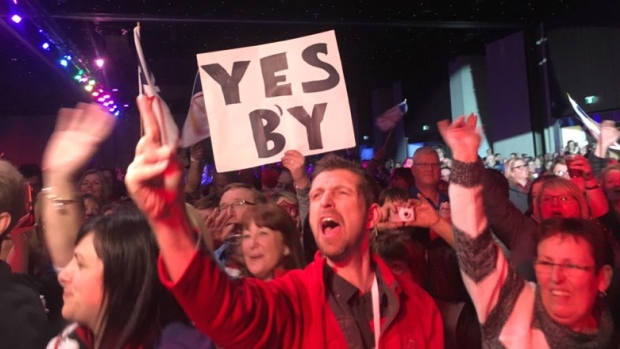
Pat Ryan: Champion Curler on the Ice, Elvis Singer off the Ice (Edmonton, 1987)
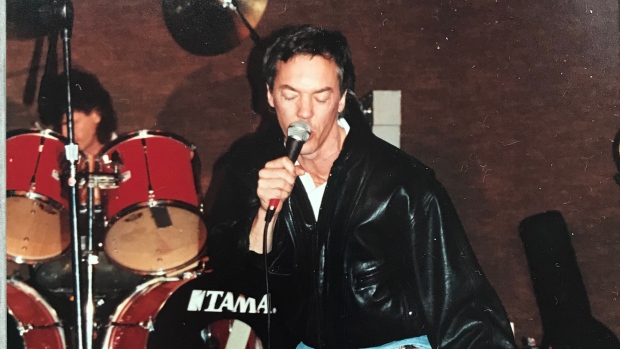
Three-time Canadian champion Pat Ryan is best known for captaining the Ryan Express, a heavy-hitting foursome that dominated men’s curling in the late 1980s. After games, however, the Edmonton native’s popularity grew in the Patch with his emergence as a talented musician.
Today, Ryan mostly sings original songs, but during his playing days it was all about Elvis. Starting at the 1979 Brier in Ottawa, Ryan would regularly get on stage at the Patch during Brier week to belt out classics by the King.
Ryan takes a look back at his Patch singing days, and one particular moment that got a bit overwhelming in his hometown.
TSN: Why Elvis?
Pat Ryan: That's what people wanted. Once they decided it was my turn they started chanting and basically I had to go. There was no way out. Once I did it once or twice, it sort of became an expectation at the Briers.
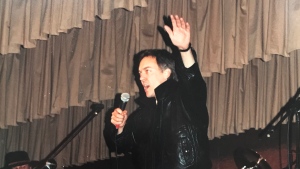
TSN: Which Elvis song was your favourite to perform?
Ryan: I think “Are You Lonesome Tonight?” was one of the ones people kind of expected. So that was almost always one of the ones that I would do. But if the band knew Elvis songs, then we could do a whole set. Generally, the bands were pretty adept. It was all Elvis songs back then. I don't do Elvis anymore. I started doing and writing my own, so now I kind of do original music almost exclusively, but I'll still throw in a few Elvis songs when I perform now. Back in those days I could sound a lot like Elvis if I wanted to and that was the intent was to mimic his tones. So, it took me a while after that to try and figure out what is my voice.
TSN: Any particular moment stand out from your Patch singing days?
Ryan: I do remember in Edmonton [in 1987]. My team wanted to go to the Patch so we went and I sang. But when we came back to the table there was such a crowd around us. I was getting kind of swarmed and I just got kind of claustrophobic. My team was having a great time because I was getting surrounded by fans. It was fun for a while, but then I got claustrophobic and I wanted to go, but the guys were saying no. They're sitting at the table talking and having a beer. I remember I went down and crawled under the table. I sat under the table on the floor while they sat at the table talking just to get away. So, I remember spending 15 minutes just sitting under the table, in between where they were seating, by myself. It sounds silly, but that was kind of at the height of our interest.

Ryan: Oh, we had team pins, too. That probably didn't help. We had a bunch of pins made up for our team called “The Ryan Express.” We were giving these out to people and I think when the word got out it was like when you start feeding ducks. They all somehow know and start coming out. There was a frenzy of people trying to get in. We laughed as a team. We said, ‘I don't think they even see our face when they’re coming and talking and nodding at us. All they see is a big pin on our shoulders.’ I think that didn’t help. That probably, in retrospect, started a bit of the frenzy.
TSN: Next year’s Brier is coming to Kelowna, the city you currently reside in. Will you be dropping by the Patch for a couple performances?
Ryan: I would think it would be pretty difficult for me to go there and not be hauled up on stage. Even if it's not there, it could be in the Purple Heart lounge. I’ve never gotten out of there without having to sing. They always say, 'what are you going to sing for us now before we let you go.’ The fans are really, really caring. If I sounded terrible they'd still cheer.
The Kings of the Patch Go Bald (Edmonton, 2007)
During their heyday in the early 2000s, the “Ferbey Four” were kings on the ice as well as in the Patch.
Randy Ferbey, David Nedohin, Scott Pfeifer and Marcel Rocque won four Brier titles and three world championships over a five-year span from 2001 to 2005. They quickly become one of the most popular rinks in curling, not only because of their tremendous success, but their willingness to show up at the Patch on a nightly basis.
Nedohin, who threw last rocks as the team’s fourth, explains what went into their decision to become Patch regulars and recalls one particular moment from the 2007 world championships in Edmonton where they went bald for a good cause.
TSN: The Canadian championship is one of the most intense and competitive bonspiels in curling. How did Team Ferbey find the time and energy to go to the Patch every night?
David Nedohin: I remember the first provincials we ever won and we sat down right afterwards, it was right there where Randy said 'just so you guys know we go to the Patch every single day.' And we kind of laughed and he was like 'No, I'm serious. Even if it's like for 10 minutes and we walk around. You make sure you plan on it, it's extremely important. The only reason we get to play in those great venues is because the fans are there to buy tickets. It's part of what we do....there's no question Team Ferbey stops in the Patch every single day.' That's just part of what we did. It didn't matter if we won or lost, we went to the Patch every day.
TSN: What was the most memorable Patch during your playing days?
Nedohin: The Saskatoon Brier in 2004. It was so big that they had street signs so that you could look up and try to meet people. You just had to meet them at the corner of whatever and whatever street because I think there were over 3,000 people in the Patch. Some of them didn't even know there was a curling event going on. It just didn't matter to them.
TSN: Team Ferbey wasn’t playing at the 2007 world championships in Edmonton, but still managed to make headlines at the Patch. What happened?
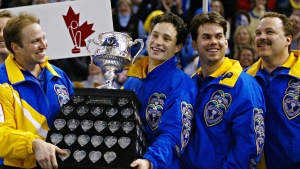
Nedohin: Glenn Howard was the team that was representing Canada. Earlier that year somebody had sent us an email just telling us how silly we looked and how we needed to clean up and look better, look professional and our hair was scraggly. So we took that as a personal challenge and we didn't cut our hair the entire year and did the head shaving fundraiser here in the Patch. We did it for my Dad, who battled cancer for many, many years. We did it in honour of him. We raised money. We raised $50,000 on that day from the fans in the Patch. Actually one fan paid $10,000 to come up and shave my head on stage. And of course she got a nice little...I don't know why she would want some of my hair in a Ziploc bag. That just goes to show the spirit of the curling fan. The fact that we raised $50,000 on that day for cancer research, I mean that's probably a memory that tops all of our championships. It's just unbelievable.
TSN: What did everybody look like before the shaving of the heads?
Nedohin: Well, Randy's didn't grow too much, I'll be honest. It was a little scruffy looking. Scott had hair down to his shoulders basically. Mine was just a giant mop and Marcel's was just kind of like long, like a biker look. It was really funny. We just looked terrible.
TSN: What’s special about the Patch?
Nedohin: It's a big part of curling. It's one of the great things about it that you can sit down and socialize with the players that you're there to see. I'll be honest, it's unfortunate that that has changed a little bit over time. Players don't go to the Patch or socialize with the fans like they used to and do find that to be one of the disappointing changes to the game, but for us that was a big part of it. The fans were just so great for so many years to us. They loved seeing us there.
Patch Facts
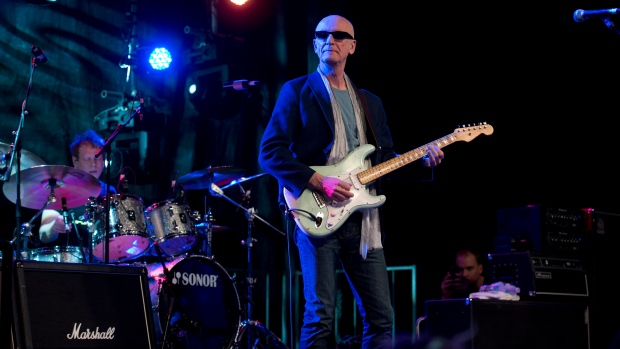
First Patch: The official “Brier Patch” debuted at the 1982 Canadian championship in Brandon, Man., thanks to Don Pottinger’s host committee. “They had a room right across from the main arena at the Concourse,” said former Curling Canada director of event operations Warren Hansen. “It wasn’t big, but it held about 500 people and they decided to call it the Brier Patch. It was a host committee creation. And it went from there.”
Most Successful Patch: The largest and most successful Brier Patch took place in Regina, Sask., in 2006. They used an indoor soccer field that covered approximately 100,000 square feet. Blue Rodeo played on opening night that cost organizers $70,000. “We started selling tickets to the Patch that were separate than the arena. We marketed as a whole separate entity. We got into some issues because there were times we had lineups of a couple thousand people after the game was over with people trying to get into the Patch,” said Hansen. “As a result of what we did with the Patch there, it was the most successful financial Patch we ever had as well. It made more money than the arena did.”
Biggest Act: The biggest musical act hired for the Patch was Burton Cummings for the 2008 Brier in Winnipeg. He was booked for an opening night performance at a cost of $100,000.
Newfoundlanders, the Unicorn Song and Beer Can Pyramids (Sault Ste. Marie, 1990)
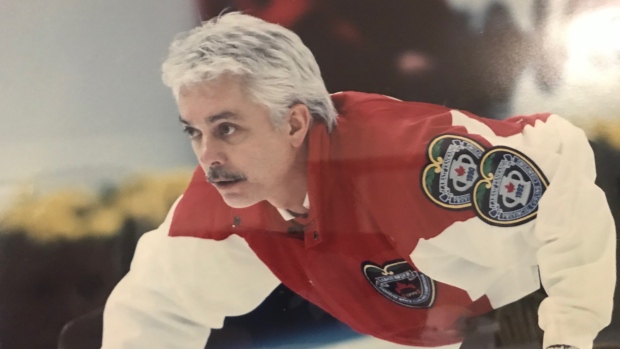
Glenn Goss skipped Team Newfoundland at the 1990 Brier in Sault Ste. Marie, Ont., and it’s fair to say the foursome out of the St. John’s Curling Club had a fun week, both on the ice and in the Patch.
Goss relives how his squad, with the help of the many Newfoundlanders in attendance, got the party started.
TSN: How often did your team go to the Patch during your Brier days?
Glenn Goss: We'd make an appearance over there at least once a day. We'd be there in the evenings especially if we weren't playing too early in the mornings. We always made a point [of going]. It was part of it for us. At that time, there weren’t a whole lot of guys spending time a whole lot of time at the gym. That's the truth of it – 1990 was my first trip to a Brier so I was trying to take in as much as I possibly could, which, as it turns out, is a mistake when you go to the Brier. Because you can't take it all in and by Thursday you're gone physically…I think going to the Brier Patch is a part of the experience and it's one that I would have regretted not doing had I stayed away.
TSN: What do you remember from the 1990 Brier Patch?
Goss: It was our night to do something in the Brier Patch. So, the Newfoundland team got up and sang the Unicorn song. The song has Irish roots, but Newfoundlanders and Irishmen consider themselves one and the same. So we were up on stage and the chorus would be ‘green alligators and long-neck geese,’ and there are actions to it. ‘And the loveliest of all was the Unicorn,’ was the last line of each verse and when you say [that part] you had to put your beer can or beer bottle on your forehead to make it look like a horn of a Unicorn. We did that on stage and hundreds of people in the Patch would have a beer can stuck to their foreheads…People ask me how can you remember that from 30 years ago. I say ‘you can’t consume enough beer to forget singing a song on stage in front of hundreds of people with a beer can stuck to your forehead.’
I think it sort of got the party started and it just went from there. Newfoundlanders are like Irishmen, I suppose. They are sociable. I think it sort of ballooned from there and became a little bit of a competition in the Patch where groups of fans, some were true Newfoundlanders, some I think wanted to be honourary ones, just started emptying beer cans and stacking them. Some of them were ridiculous...jeez. How they got them as high as they got them without having them topple over was amazing.
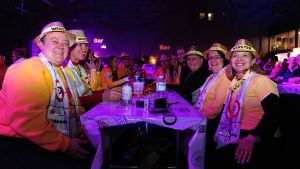
TSN: Did you make any new friends with fellow curlers at the Patch?
Goss: Al Hackner and I got to know each other a little bit at the Brier [in 1992]. We would stand around and have a beer together at the Patch and people used to come up, particularly the ladies would come up, and look for Al Hackner's autograph and when I was standing next to him they would ask me for the same thing. Where they would ask you to sign is nobody's business...where they wanted the signatures. It was bizarre. That was something that really stood out. We sort of looked at each other and said, ‘jeez, this is nuts.’
TSN: Any other stories from the Patch?
Goss: I think at that same Brier [1992] there was a group of people, I can’t remember where they were from, but they didn't have a hotel room. They spent 10 days in the Patch. They put their luggage and everything in the corner and that's where they stayed. They just didn't leave. They stayed in the corner of the Patch. They didn’t have a hotel room! They put their luggage in the corner and changed their clothes. That's where they lived.
TSN: What is the importance of the Patch?
Goss: A lot of it was you get an opportunity to meet people that you never get a chance to meet any other time. It's incredible how long lasting those friendships are that you do form over a short week…That’s the beauty of it. The Brier Patch was just an opportunity for you to get in there, let your hair down, be who you were and I think everybody that took part thoroughly enjoyed it. I know I certainly did and I wouldn’t change a thing.
